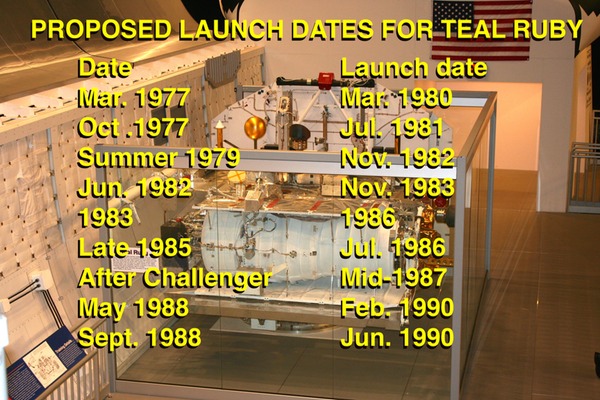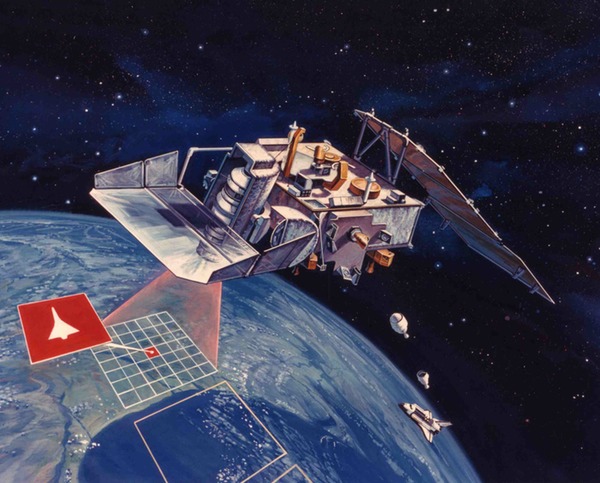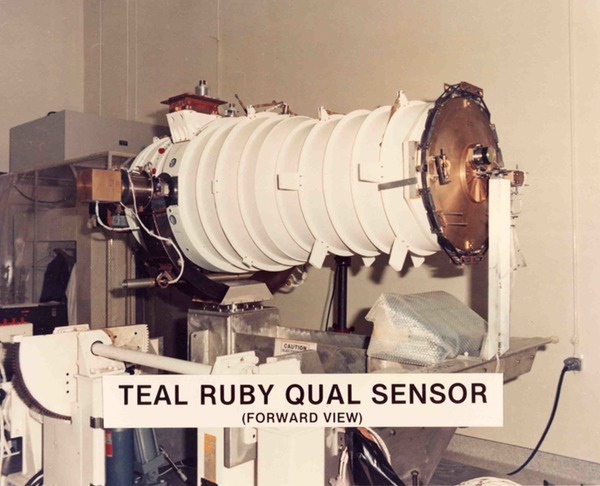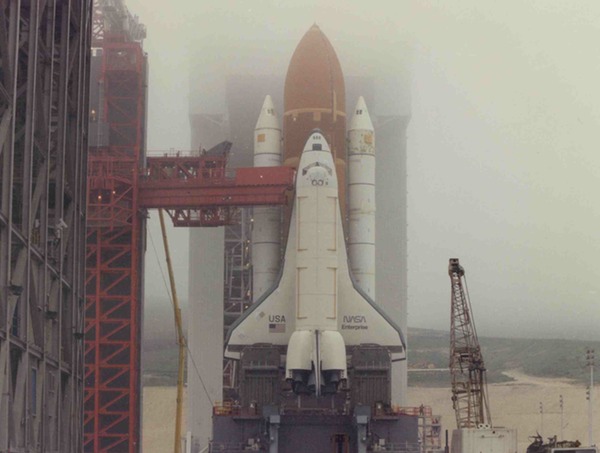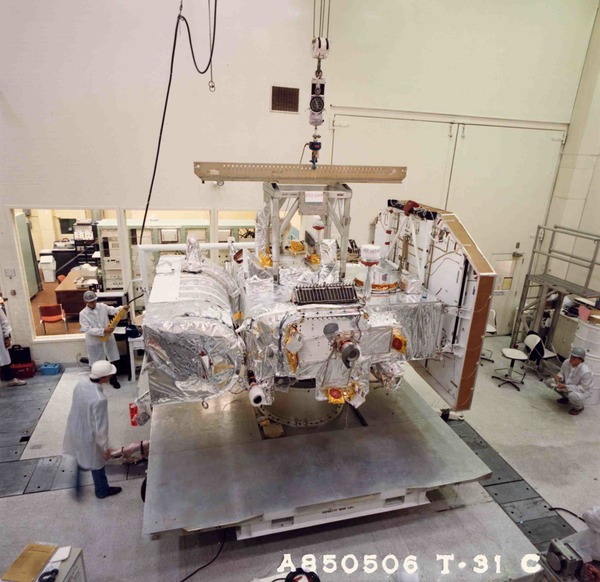Ugly little gem: The Teal Ruby satellite<< page 1: Teal Ruby’s origins The sensitive infrared telescope was not the only payload scheduled for Teal Ruby. Three secondary payloads were also planned to be carried on the spacecraft bus. The biggest and most important of these was an experimental communications package that offered the possibility of revolutionizing space-ground communications.
In August 1976, the Air Force conducted a preliminary design review of a satellite transmitter being developed by McDonnell Douglas for Program 405B, a laser communications development project. This technology, known as Lasercom, offered the potential to transmit huge amounts of data over a communications link that could not be intercepted or jammed by an enemy. The Air Force soon decided to incorporate an experimental communications receiver into the Teal Ruby spacecraft. The goal was to test the system for approximately six months, including attempts to jam it from the ground. In a ground test at White Sands in 1978 a laser beam was reflected off a steerable mirror located atop a tower half a mile away, but the engineering team wanted to shoot it much higher up. Two other small payloads were also scheduled for the Teal Ruby spacecraft. A $9-million ion propulsion unit developed by NASA’s Lewis Research Center was to operate after the infrared sensor tests had completed, so as not to contaminate the optics. An extreme ultraviolet (EUV) photometer developed by the University of California at Berkeley was also planned to be carried.
But after part of the EUV payload was deleted by early 1980, the Air Force chose to add a laser transmitter to the spacecraft in addition to the receiver. By this time the Air Force had conducted tests with a C-135 aircraft flying a racetrack pattern at 9,100 meters (30,000 feet) and receiving data at 100 bits per second from a ground-based laser. In addition to pointing a laser at the Teal Ruby spacecraft and demonstrating the ability to transmit data to it at 100 bits per second, the Air Force wanted to put a small laser on the spacecraft and try to communicate with the plane and the ground from orbit. An off-the-shelf gallium arsenide laser would be installed on the spacecraft to transmit data back to earth at 800 bits per second, but would only be in view of the ground station for about ten minutes. The Lasercom package promised some great advantages over traditional radio communications. In transmitting from the ground to the spacecraft, the ground footprint visible by the spacecraft would be no more than two miles wide, providing great privacy and jam resistance because an adversary would have to be that close to the ground station to jam the signal. But weather was a problem for the laser system. High data rates had not been achieved through clouds. And the experimental system that the Air Force planned to test had a low data rate. Between 1980 and 1982 the Lasercom development ran into problems and it soon became apparent that it could not be made to work. By August 1982 the Air Force deferred the Lasercom Space Measurement Unit and soon deleted it from the Teal Ruby spacecraft entirely, replacing it with a US Navy experiment called the Stellar Horizon Atmospheric Dispersion sensor. However, by this time Teal Ruby’s infrared sensor development overshadowed all other problems on the spacecraft. The most complex part of Teal Ruby was the sensor and its 150,000 detectors. The initial contract for the sensor was $25 million, with an expected additional $25 million for support, mission planning and other costs. However, by July 1981 the costs had more than doubled to $110 million. The cost increase was primarily due to problems manufacturing the thousands of detector chips. They had to be individually tested, and many failed. Soon the designers encountered other problems, such as developing electronics that could operate at the –375-degree temperature required by the sensor. The Teal Ruby spacecraft was then about 60 percent complete, with propellant systems and electrical wiring installed. But subsystem hardware had not yet been incorporated. The satellite weighed 2,180 kilograms (4,800 pounds) and, with its shuttle payload bay cradle, would weigh 4,080 kilograms (9,000 pounds).
The sensor development problems persisted and, by June 1982, the program was restructured and the launch was rescheduled for November 1983. But the problems did not get solved and a year later the launch date slipped again, to 1986. By 1983 program costs had increased to about $500 million, or about eight times the original cost, and the development time had nearly tripled.
Eventually, by the end of 1983, the major problems appeared to have been solved and the concept and design of the Teal Ruby spacecraft were finally qualified. A qualification infrared sensor was tested on the ground for two months at Rockwell. Six months later, the AFP888 spacecraft and its sensor entered system acceptance testing at Rockwell’s Satellite Systems Division in Seal Beach, California, and the development effort finally appeared to be nearing completion. After the difficult development, the sensor testing apparently went smoothly and produced some surprising results. The sensor exceeded performance requirements during ground testing, and tests showed that the sensor was capable of detecting targets such as cruise missiles, ships, and ground-based weapons. The program ran into a new but apparently minor problem in summer 1985 when testing exposed a flaw in the sensor that designers called a “thermal short.” Once the satellite was placed into the shuttle’s cargo bay on the launch pad, it would no longer be cooled. The sensor was designed to last several days in this condition, assuming that there were launch delays. But during testing Rockwell engineers discovered that far more heat than planned leaked in through the sensor and launch delays could seriously shorten the satellite’s lifetime in orbit. This flaw had to be corrected before the satellite could be launched. In February 1985, the Defense Department announced the crew of the first Vandenberg shuttle mission, which would carry the spacecraft into orbit: Navy Captain Robert L. Crippen, Air Force Lieutenant Colonel Guy S. Gardner, USAF Major Jerry L. Ross, Navy Commander Dale A. Gardner, and USAF Colonel R. Michael Mullane. By the end of 1985 it seemed as if the Teal Ruby program was finally on track for launch, then scheduled for July. The spacecraft was ready, the shuttle was ready, and SLC-6 was supposedly going to be ready.
The Teal Ruby test program was complex and ambitious. About 100 target identification missions were planned for the one-year operational life of the sensor. Aircraft would fly across the sensor’s field of view and the spacecraft would attempt to both locate and track them, either in a stationary staring mode or with the sensor moving within its gimbal mount. Ground personnel would be in target areas on some of the Teal Ruby missions to gather data on weather and other factors that could affect the tests. The sensor would also be used to gather data on background temperatures. In particular, much of the data collection was to be conducted over the ice fields north of Canada. The scattered ice flows and significant temperature differences between ice and the surrounding water would provide a major challenge for the sensor. The program office was preparing for both the launch and the complex testing phase when the Challenger exploded and all plans were placed on hold. Soon after the Challenger accident the Teal Ruby launch was delayed until mid-1987 at the earliest. But late in 1986 the Air Force leadership made a decision that stunned many people in the Air Force, NASA, and the public—the Secretary of the Air Force decided to close down the SLC-6 facility and not launch any shuttles from Vandenberg. The reasons for this decision have never been explained in detail. The SLC-6 facility had experienced many development problems, but most of these were either fixed or were being fixed by fall of 1986.
The reasons for the closing of Vandenberg appear to have more to do with the military’s opinion of the shuttle than the launch site. The shuttle had never been a popular vehicle for either the Air Force or the secret organization that managed spy satellite programs, the National Reconnaissance Office (NRO). The NRO had actively resisted transferring its spacecraft to the shuttle in the 1970s. By the early 1980s, the Air Force began procuring additional expendable launch vehicles to carry classified payloads into orbit, payloads that were originally scheduled to fly aboard the shuttle from Vandenberg. Clearly the Air Force and the NRO wanted to get off the Space Shuttle and use expendable launch vehicles instead. With the shuttle fleet grounded, the Air Force decided to get off the shuttle for good, although this would take time. Any payload that could be shifted to an expendable launch vehicle was removed from the shuttle manifest. But some satellites clearly could not be switched to expendables and would require shuttle launch. The Air Force decision to close the Vandenberg launch site must have been a difficult one to make, because it ultimately required several classified payloads be launched on the shuttle from the Kennedy Space Center into less than ideal orbits. The Air Force studied whether Teal Ruby could be launched on an expendable booster, but concluded that this was not possible without significant and costly redesign. In December 1986, Department of Defense officials called for an expedited launch of Teal Ruby once the shuttle returned to flight. But it would have to fly out of Kennedy Space Center and could only reach an orbital inclination of 57 degrees, instead of 72 degrees. The lower inclination would limit testing to regions such as western Alaska or eastern Canada where background temperature variations would not be as great as farther north. The higher inclination would have allowed flying over broken ice, presenting a major challenge for the sensor in terms of ground clutter. The jumbled background would have had temperatures that varied by as much as 14–22 degrees Celsius (25–40 degrees Fahrenheit). Teal Ruby would not return as much useful information at this lower orbit.
While Teal Ruby was in development, CCD arrays were improving, slowly. By spring 1986, researchers were working with focal plane arrays with about 200,000 elements, but foresaw the need to develop advanced arrays with up to 2 million elements. The technology is not directly applicable to the CCD arrays in modern digital cameras—the CCDs the military was interested in had to operate at extremely cold temperatures—but today it is common for inexpensive commercial digital cameras to have significantly more than 10 million elements. But there were other developments that were making Teal Ruby’s sensor increasingly irrelevant. Starting in the mid-1970s, the Air Force’s Defense Support Program (DSP) satellites had detected unusual heat targets. The DSP had been designed to look for the heat generated by relatively hot ballistic missiles. But soon after DSP entered service, Aerospace Corporation scientists began detecting other heat targets, including surface-to-air missiles and ground explosions. The company’s scientists and engineers also began noticing unusual infrared events. These infrared returns occurred over Soviet territory at regular intervals and traveled in relatively straight lines. They were clearly not ballistic missiles. They soon determined that they were originating at Soviet bomber bases, notably those that fielded Backfire bombers. For the next several years, Aerospace Corporation scientists tried to interest the Air Force in studying this data more closely and possibly using it as a source of intelligence. Ultimately, the US Navy fielded the SLOW WALKER Reporting System, or SLWRS, which used DSP data to track the movements of Soviet bombers. By the late 1980s, the Navy improved its SLOW WALKER capability to the point where the information was disseminated nearly instantaneously. Now the DSP satellite, with technology older than that developed for Teal Ruby, was performing an operational mission while the expensive experimental satellite still sat on the ground. By May 1988, shortly before the Space Shuttle resumed flying, Teal Ruby was officially scheduled for launch in February 1990 aboard STS-37 from Kennedy Space Center. But when the shuttle resumed flight in September 1988, the Teal Ruby launch had slipped again, to no earlier than June 1990. Teal Ruby was now living on borrowed time. In 1987 DARPA and the Air Force agreed that DARPA would stop funding the sensor by 1989 and the Air Force would pick up all costs afterwards. However, this would be expensive because delays had led scavengers from other space projects to borrow ground equipment that had to be replaced, requiring the Air Force to provide an additional $80–90 million simply to get the program back on track. Soon Air Force officials decided that the costs of replacing the equipment and taking over funding for the sensor from DARPA were too great and did not ask for more funds in the 1989 budget request. As a result, Congress deleted all funding due to the project’s unclear future. With no more money, the Teal Ruby project was officially canceled in October 1988. Teal Ruby was designed to prove a concept that had long been proven by the older sensors on the DSP. Furthermore, the Backfire bomber that had been a major concern in the mid-1970s was no longer threatening over a decade later, particularly to the Air Force. Intelligence agencies had long concluded that the Backfire lacked the range to reach the United States, and it could be tracked by other means. The Navy already had an operational system for tracking Backfires. With the Cold War cooling off by the end of the 1980s, it was also unlikely that the Air Force would receive approval to build the complicated Space Based Wide Area Surveillance system that some officials still wanted.
In January 1990, the Teal Ruby spacecraft was moved from its cleanroom storage at Rockwell International to a climate-controlled storage facility at Norton Air Force Base in California. The Navy’s Stellar Horizon Atmospheric Dispersion experiment was removed, along with the University of California at Berkeley’s Extreme Ultraviolet experiment. The NASA ion propulsion unit had been removed some time earlier. The AFP888 spacecraft was then used in ground tests of how satellite components aged. According to one account, the infrared sensor was later donated to a university astronomy program. Today Teal Ruby is only a footnote in the history of the Cold War space program. But throughout the 1980s it represented many of the worst attributes of the military space bureaucracy, suffering excessive cost overruns and schedule delays and ultimately producing no useful data. Adjusted for inflation, the satellite cost approximately a billion dollars in today’s money, and never flew. The trade magazine Aviation Week & Space Technology conducted a post-mortem of the project when it was finally canceled and found that many of its problems could have been avoided with better management. The magazine determined that a major cause of the problems was underestimating the challenges of building the focal plane array sensor. CCD technology was not sufficiently mature and Rockwell had major difficulties manufacturing and testing the chips. The company also ran into problems with focal plane design and assembly, lightweight optic design and construction, cryogenic temperature electronics, and two-element cryostat design. But it was DARPA and the Air Force, and not the contractor, that ultimately received blame for Teal Ruby’s problems. Despite the fact that the Teal Ruby focal plane was one of the most advanced sensors ever conceived for a spacecraft, the two organizations had decided not to conduct an assessment of the technical challenges involved in building the spacecraft before they started. They had also not required detailed cost reporting. As a result, costs spiraled and problems stacked up. And Teal Ruby never became the jewel in the sky it was born to be. Home |
|
